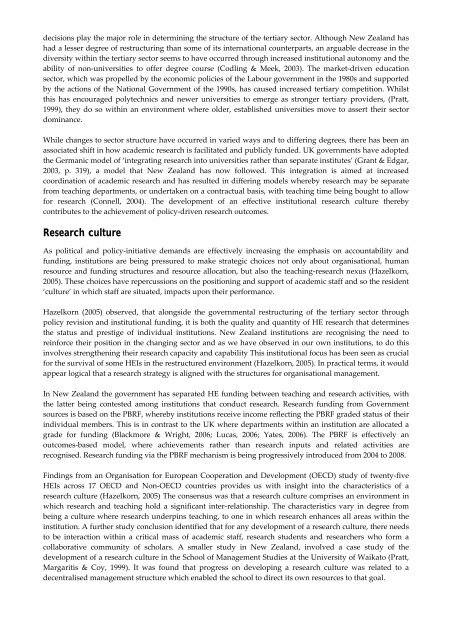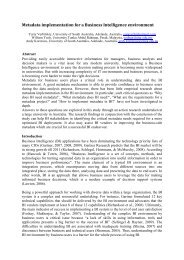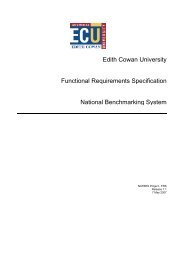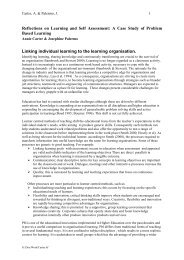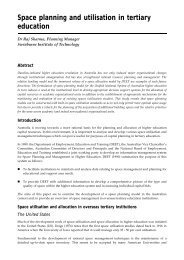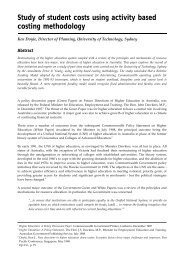Research in progress: Mapping the terrain of two applied ...
Research in progress: Mapping the terrain of two applied ...
Research in progress: Mapping the terrain of two applied ...
Create successful ePaper yourself
Turn your PDF publications into a flip-book with our unique Google optimized e-Paper software.
decisions play <strong>the</strong> major role <strong>in</strong> determ<strong>in</strong><strong>in</strong>g <strong>the</strong> structure <strong>of</strong> <strong>the</strong> tertiary sector. Although New Zealand has<br />
had a lesser degree <strong>of</strong> restructur<strong>in</strong>g than some <strong>of</strong> its <strong>in</strong>ternational counterparts, an arguable decrease <strong>in</strong> <strong>the</strong><br />
diversity with<strong>in</strong> <strong>the</strong> tertiary sector seems to have occurred through <strong>in</strong>creased <strong>in</strong>stitutional autonomy and <strong>the</strong><br />
ability <strong>of</strong> non‐universities to <strong>of</strong>fer degree course (Codl<strong>in</strong>g & Meek, 2003). The market‐driven education<br />
sector, which was propelled by <strong>the</strong> economic policies <strong>of</strong> <strong>the</strong> Labour government <strong>in</strong> <strong>the</strong> 1980s and supported<br />
by <strong>the</strong> actions <strong>of</strong> <strong>the</strong> National Government <strong>of</strong> <strong>the</strong> 1990s, has caused <strong>in</strong>creased tertiary competition. Whilst<br />
this has encouraged polytechnics and newer universities to emerge as stronger tertiary providers, (Pratt,<br />
1999), <strong>the</strong>y do so with<strong>in</strong> an environment where older, established universities move to assert <strong>the</strong>ir sector<br />
dom<strong>in</strong>ance.<br />
While changes to sector structure have occurred <strong>in</strong> varied ways and to differ<strong>in</strong>g degrees, <strong>the</strong>re has been an<br />
associated shift <strong>in</strong> how academic research is facilitated and publicly funded. UK governments have adopted<br />
<strong>the</strong> Germanic model <strong>of</strong> ‘<strong>in</strong>tegrat<strong>in</strong>g research <strong>in</strong>to universities ra<strong>the</strong>r than separate <strong>in</strong>stitutes’ (Grant & Edgar,<br />
2003, p. 319), a model that New Zealand has now followed. This <strong>in</strong>tegration is aimed at <strong>in</strong>creased<br />
coord<strong>in</strong>ation <strong>of</strong> academic research and has resulted <strong>in</strong> differ<strong>in</strong>g models whereby research may be separate<br />
from teach<strong>in</strong>g departments, or undertaken on a contractual basis, with teach<strong>in</strong>g time be<strong>in</strong>g bought to allow<br />
for research (Connell, 2004). The development <strong>of</strong> an effective <strong>in</strong>stitutional research culture <strong>the</strong>reby<br />
contributes to <strong>the</strong> achievement <strong>of</strong> policy‐driven research outcomes.<br />
<strong>Research</strong> culture<br />
As political and policy‐<strong>in</strong>itiative demands are effectively <strong>in</strong>creas<strong>in</strong>g <strong>the</strong> emphasis on accountability and<br />
fund<strong>in</strong>g, <strong>in</strong>stitutions are be<strong>in</strong>g pressured to make strategic choices not only about organisational, human<br />
resource and fund<strong>in</strong>g structures and resource allocation, but also <strong>the</strong> teach<strong>in</strong>g‐research nexus (Hazelkorn,<br />
2005). These choices have repercussions on <strong>the</strong> position<strong>in</strong>g and support <strong>of</strong> academic staff and so <strong>the</strong> resident<br />
‘culture’ <strong>in</strong> which staff are situated, impacts upon <strong>the</strong>ir performance.<br />
Hazelkorn (2005) observed, that alongside <strong>the</strong> governmental restructur<strong>in</strong>g <strong>of</strong> <strong>the</strong> tertiary sector through<br />
policy revision and <strong>in</strong>stitutional fund<strong>in</strong>g, it is both <strong>the</strong> quality and quantity <strong>of</strong> HE research that determ<strong>in</strong>es<br />
<strong>the</strong> status and prestige <strong>of</strong> <strong>in</strong>dividual <strong>in</strong>stitutions. New Zealand <strong>in</strong>stitutions are recognis<strong>in</strong>g <strong>the</strong> need to<br />
re<strong>in</strong>force <strong>the</strong>ir position <strong>in</strong> <strong>the</strong> chang<strong>in</strong>g sector and as we have observed <strong>in</strong> our own <strong>in</strong>stitutions, to do this<br />
<strong>in</strong>volves streng<strong>the</strong>n<strong>in</strong>g <strong>the</strong>ir research capacity and capability This <strong>in</strong>stitutional focus has been seen as crucial<br />
for <strong>the</strong> survival <strong>of</strong> some HEIs <strong>in</strong> <strong>the</strong> restructured environment (Hazelkorn, 2005). In practical terms, it would<br />
appear logical that a research strategy is aligned with <strong>the</strong> structures for organisational management.<br />
In New Zealand <strong>the</strong> government has separated HE fund<strong>in</strong>g between teach<strong>in</strong>g and research activities, with<br />
<strong>the</strong> latter be<strong>in</strong>g contested among <strong>in</strong>stitutions that conduct research. <strong>Research</strong> fund<strong>in</strong>g from Government<br />
sources is based on <strong>the</strong> PBRF, whereby <strong>in</strong>stitutions receive <strong>in</strong>come reflect<strong>in</strong>g <strong>the</strong> PBRF graded status <strong>of</strong> <strong>the</strong>ir<br />
<strong>in</strong>dividual members. This is <strong>in</strong> contrast to <strong>the</strong> UK where departments with<strong>in</strong> an <strong>in</strong>stitution are allocated a<br />
grade for fund<strong>in</strong>g (Blackmore & Wright, 2006; Lucas, 2006; Yates, 2006). The PBRF is effectively an<br />
outcomes‐based model, where achievements ra<strong>the</strong>r than research <strong>in</strong>puts and related activities are<br />
recognised. <strong>Research</strong> fund<strong>in</strong>g via <strong>the</strong> PBRF mechanism is be<strong>in</strong>g <strong>progress</strong>ively <strong>in</strong>troduced from 2004 to 2008.<br />
F<strong>in</strong>d<strong>in</strong>gs from an Organisation for European Cooperation and Development (OECD) study <strong>of</strong> twenty‐five<br />
HEIs across 17 OECD and Non‐OECD countries provides us with <strong>in</strong>sight <strong>in</strong>to <strong>the</strong> characteristics <strong>of</strong> a<br />
research culture (Hazelkorn, 2005) The consensus was that a research culture comprises an environment <strong>in</strong><br />
which research and teach<strong>in</strong>g hold a significant <strong>in</strong>ter‐relationship. The characteristics vary <strong>in</strong> degree from<br />
be<strong>in</strong>g a culture where research underp<strong>in</strong>s teach<strong>in</strong>g, to one <strong>in</strong> which research enhances all areas with<strong>in</strong> <strong>the</strong><br />
<strong>in</strong>stitution. A fur<strong>the</strong>r study conclusion identified that for any development <strong>of</strong> a research culture, <strong>the</strong>re needs<br />
to be <strong>in</strong>teraction with<strong>in</strong> a critical mass <strong>of</strong> academic staff, research students and researchers who form a<br />
collaborative community <strong>of</strong> scholars. A smaller study <strong>in</strong> New Zealand, <strong>in</strong>volved a case study <strong>of</strong> <strong>the</strong><br />
development <strong>of</strong> a research culture <strong>in</strong> <strong>the</strong> School <strong>of</strong> Management Studies at <strong>the</strong> University <strong>of</strong> Waikato (Pratt,<br />
Margaritis & Coy, 1999). It was found that <strong>progress</strong> on develop<strong>in</strong>g a research culture was related to a<br />
decentralised management structure which enabled <strong>the</strong> school to direct its own resources to that goal.


